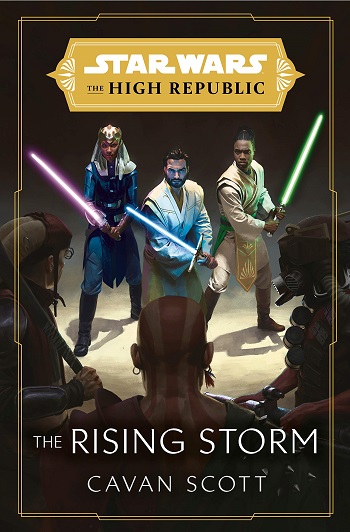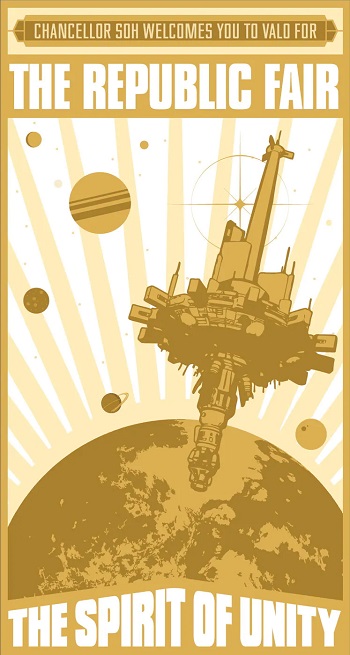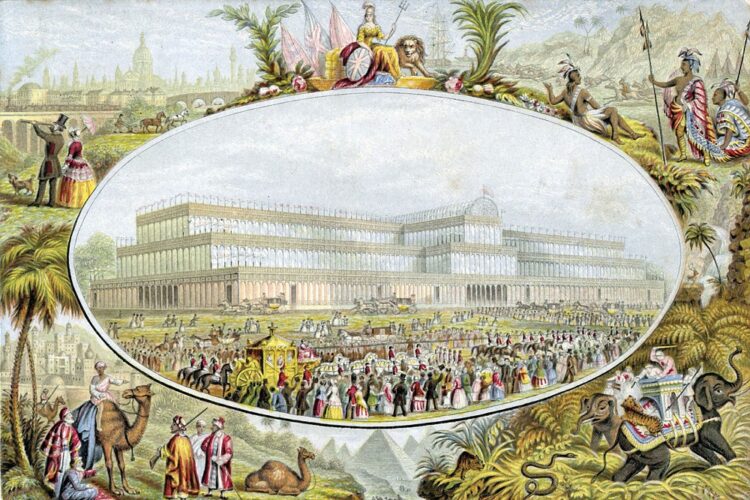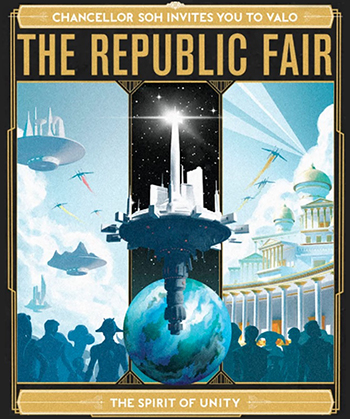
Wave two of the High Republic series revolves around the centerpiece of the Republic Fair, modeled on the 18th-to-20th century concept of the World’s Fair. In real life, these fairs were huge expositions designed to showcase the wonders of science, technology, and the globe in an era where most of the population could only see the rest of the world through illustrations in books. Star Wars often uses the design vocabulary of real-world history and times gone past, and the world’s fair concept fits right into the idea of the Republic of yesteryear, full of innovation and optimism.
The opening wave of The High Republic showed us that despite appearances, all isn’t right with the galaxy. The second wave of novels shows us that the galaxy’s troubles are just beginning – the Republic and Jedi may blaze with light and life, but trouble is on the horizon. Cavan Scott’s The Rising Storm may just as easily have been named Before the Storm, had that name not already been taken by an existing Star Wars Legends novel.
The Rising Storm is all about the Republic Fair. Personally, I think the Republic Fair is a great concept – both in-universe and out-of-universe. In-universe, Chancellor Lina Soh has a pretty wonderful idea to unify the galaxy and showcase the benefits of the shared galactic government through a showcase of shared science and culture – but was this really the right time? Out-of-universe, putting the real-world idea of a global exposition into Star Wars was an inspired idea – but is the idea used to its full potential?
I think the answer is “mostly”, but there are some avenues I wish the story had explored to make the High Republic setting seem more interesting. The in-universe shortcomings of the fair – that it might not be the best time – are actually great for the story! But there are some ideas that aren’t raised in-universe, which makes me a little disappointed. Don’t get me wrong, I still think the Republic Fair is a marvelous idea and I enjoyed The Rising Storm for the most part! My excitement is just tempered slightly by roads not trodden that would have made better use of the High Republic – and I won’t beat around the bush, it has a lot to do with the fact that the real-life World’s Fairs were also in the shadow of a gilded age of industry and colonialism and we see little sign of that in The Rising Storm. Maybe that’s not the story they set out to tell – but it’s an unfortunate omission.
A Wondrous Idea
The concept of the Republic Fair is a winner in my book. I love the idea. Progress, wonder, and invention fit what appear to be the core themes of The High Republic as a series. The Republic works, and does its best for the people of the galaxy just as the Jedi truly fulfill their role as guardians of peace and justice. Or so it seems, at least! There might be problems ahead – but we’ll get to that.

As described in The Rising Storm, the fair has different sections ranging from the Arts and Culture zone, the Jedi showcase called the Starlight Pavilion, a zoo with rare fauna from all over the galaxy, and even floating pavilions showcasing the worlds of the Republic (think Disney’s Epcot, but in the sky). Above all, the fair is dedicated to the Spirit of Unity – Chancellor Soh’s slogan which appears on promotional art both in-universe and out-of-universe. The fair itself is superbly realized in The Rising Storm – never described at boring expository length, but unveiled over the course of the novel. Even when things get dicey and the action begins, we still get to visit different spots of the Republic Fair. It might have been a superb VR experience – but for now, the novel does a pretty good job of making it sound amazing.
Chancellor Soh does catch some flak for it, though. She may be the Republic’s inspiring leader, but she’s not beloved by everyone. The Nihil can’t stand her, for one – she’s encroaching on their turf with her expansion of the Republic to the Outer Rim. Domestically, Senator Tia Toon of Sullust opposes the Republic Fair as hubristic and expensive. He calls it a vanity project in a time where the Republic should be increasing its military budget in response to the Nihil threat.
The chancellor did mess up. The Nihil do attack. And I think that’s great. Soh may be the chancellor the Republic needs, but she isn’t infallible. Her political opponent was correct. And unlike previous political antagonists in Star Wars, he doesn’t appear to have ulterior motives. The chancellor had a great idea at the wrong time – and the Republic’s celebration of optimism and unity going up in flames is a great image for this part of the story.
If the Republic Fair does reflect the glories and wonder of the Galactic Republic, there couldn’t be a better metaphor for the coming arc of The High Republic than this act of monumental pride (in its positive and negative aspects!) coming to ruin.
(Republic) Fair Criticism
So if the Republic Fair worked so well, what was missing? Well – a key thing to remember about these expositions in the real world is that they owe their existence to colonialism. They didn’t just overlap in time with the colonial era, they existed because of it. The prosperity that allowed for the World’s Fairs, the very ability of Western nations to showcase the rest of the world to their population was driven by exploitation and colonization of the rest of the globe. It was progress and innovation and a widening world, yes – but it was for the benefit of Western countries to the detriment of the rest of the world.

Am I saying that Star Wars needs to address the colonial background of real-life World’s Fairs? No, I’m not saying that – though you might argue there’s at least some responsibility not to cherry-pick the feel-good nostalgia and ignore the bad parts. But look – there’s a lot of bad history in our world (people were pretty awful for the majority of world history and they still are) and it would be a downer if every single work of fiction had to use a disclaimer or cover heavy real-life history.
The Republic Fair in The High Republic’s second wave is about celebrating the Republic and showing it to the Outer Rim, so it has a different basis for existing than the real-life World’s Fairs. This isn’t Britain, France, or the United States showing their people all their various ill-gotten gains – this is the Galactic Republic saying “hey, you could be a part of this great family of planets too!” while at the same time reminding the people of the Republic what they’ve gained by staying together. That’s the story that The High Republic is telling, and I get that and think it’s a great story.
But there’s some squandered potential here. I mentioned in my first piece on The High Republic a bit I loved from an interview about Starlight Beacon: the idea that the gleaming towers of Starlight are supported by the workers in the not-so-shiny underbelly of the space station. There’s this idea of inequality – that this glorious shiny Republic that performs Great Works of innovation, culture, and science might do so at the expense of the less fortunate in the Republic. Maybe the Republic Fair is a wondrous showcase of the best the Republic has to offer – but maybe it’s also only for the elite? It would be one thing if that wasn’t the story they wanted to tell, but the ideas were already there – we just didn’t see any of that aspect in The Rising Storm. And it’s perplexing, because we know where the story goes – to the lavish but corrupt Republic of the prequels. Where’s the connective tissue there? Where’s the nuance, the grime undermining the shine?

The closest we get to this idea comes in the form of the Nihil – they don’t like the Republic Fair, they don’t like the Republic showing off and getting their claws on the Outer Rim. But this is just a pretext – we know the Nihil care about nothing and believe in nothing, that’s what promotional interviews and quotes about The High Republic stressed. It’s certainly an interesting direction for villains in Star Wars, but it leaves us with a lack of nuance to the story – it’s a straightforward good-versus-evil conflict (which is fine) but it could’ve been textured a bit. The good guys are allowed to have flaws!
In fact, the Jedi are an example of where The Rising Storm does a really great job at this. The Jedi Order is gleaming and shiny, but its members aren’t perfect. They’re all individuals, with flaws and weaknesses. They’re not even immune to the lure of the dark side, it turns out. But, despite all this – what makes the Jedi really great in this era and in this book is not that they’re perfect, but that they’re willing to see their flaws and work on them. They are sensitive to their weaknesses and act to address them, unlike the later order we see in the films. To me, this really sells the idea that the Jedi of this era were great.
What could The Rising Storm have done differently? Well – if the Nihil are the Nihil and they truly believe in just raiding, that’s fine. That’s how the villains of this series work (at least, those who aren’t named Marchion Ro). We only briefly see how the rest of the Outer Rim feels about the Fair, through the Togruta (who are apparently a regional power). This is where I think the potentially interesting story elements could have come from. The Republic might not actually be a colonial power – but perhaps the people of the Outer Rim think that they are?
Or potentially even more interesting, the Republic might practice a form of neocolonialism. That’s a more modern form of exploitation that uses economic and cultural institutions to create an unequal relationship where exploitation and resource extraction still occur on behalf of the stronger power. Perhaps there are fears that the Republic’s great financial institutions might come in and take the resources of the Outer Rim worlds, and the folks from the Rim think that the Republic Fair is just tinsel and fireworks masking a power grab. Whether that’s true or not doesn’t matter much to me – it would have been a really interesting idea to engage with, especially as it would neatly echo that real-world example the Republic Fair was based on.
Don’t get me wrong, I enjoyed The Rising Storm
At the end of the day, I still really enjoyed The Rising Storm. I loved reading about the Republic Fair, and found it a delight. Heck, I wish I could experience the Republic Fair myself through a VR experience narrated by talkative Jedi archivist OrbaLin (a new favorite character of mine) or inspirational Chancellor Lina Soh (an existing favorite). The Rising Storm had great action and suspense, and after a leisurely build I found it a page-turner at the end – perfectly matching the events of the book. It’s because I love the concept of the Republic Fair that I wish more could have been done with it.
Of course, there are still more books and comics to come in this wave of The High Republic and The Rising Storm (and its release partner, Race to Crashpoint Station) might just be the beginning. Only time will tell, and I continue to hope that we get more development of the Republic Fair and the Republic itself. I love the idea that the Galactic Republic is in a golden age where the government actually works – but I’d like it even better if it were a government that worked despite its warts, rather than presenting itself as flawless.
